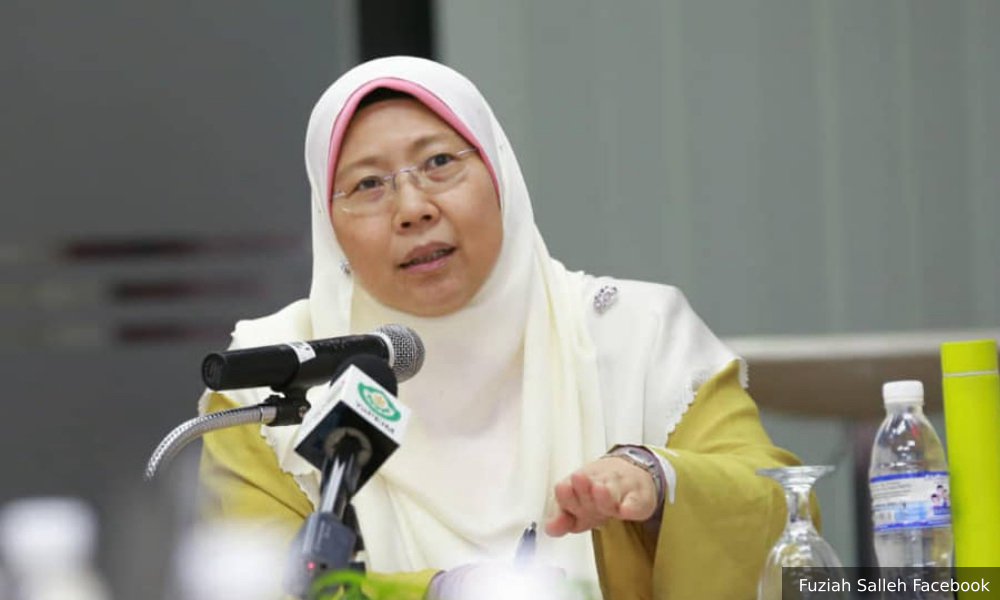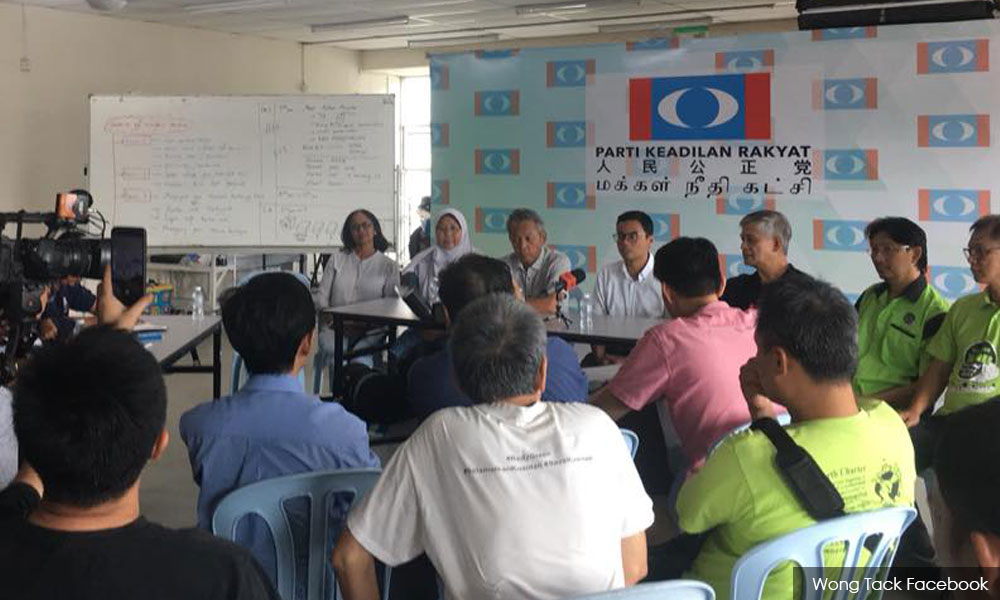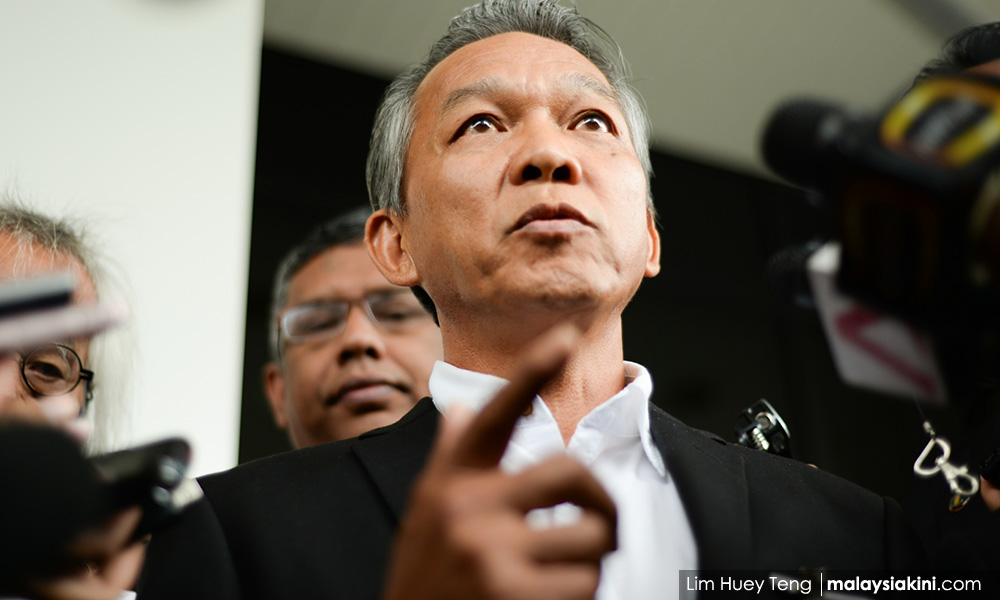An Open Letter To Tun Dr. Mahathir Mohammad
18th December 2018
Dear Esteemed Prime Minister Tun Dr Mahathir,
Please do NOT accept Najib’s Poisoned Chalice and Lynas Spin
We, the rakyat thank you for returning to the political centre stage through Pakatan Harapan (PH) to get rid of Najib and his kleptocratic regime. Sadly, Najib has left a poisoned chalice through the 100% Australian-owned Lynas rare earth plant in Malaysia. It is like the toxic legacy of the 1 MDB scandal that will continue to plague PH until it is cleaned up and sorted.
The Lynas Rare Earth Plant and its Mounts of Contaminated Waste
Tun, you are a wise Elder stateman. We hope and trust that you can see why Malaysia should enforce our law and regulations on Lynas to ensure that its hazardous waste cease to pollute our precious environment and to spiral into a serious toxic rerun.
According to Australian Stock Exchange (ASX) “Good corporate governance promotes investor confidence”. While the ASX and Australia have limited jurisdiction over Lynas’ operations in Malaysia, the PH Government has the power to ensure that Lynas truly complies with Malaysian law and regulations, as well as adhere to the ASX Corporate Governance Principles[ https://www.asx.com.au/documents/asx-compliance/cgc-principles-and-recommendations-3rd-edn.pdf p.3-4]. Sustainable development as promised in the PH Manifesto is only possible ifthe Government upholds our own law to restore order.
Many of us have contributed and campaigned for PH to be elected. We supported your leadership because we trust that you will act in Malaysia’s interest and that you will hold your words to undo past mistakes. Lynas is a major mistake committed by the Najib regime. We now count on you to join Energy, Technology, Science, Climate Change and Environment Minister Yeo Bee Yin to right this wrong to pave the way for Malaysia to pursue a new clean and safe sustainable pathway of development.
In summary:
Lynas’ waste is neither earth nor harmless and there are over 1.5 million tonnes of it contaminating our environment right now. The waste is a concoction of chemical compounds containing cancer-causing radionuclides, heavy metals and other toxic elements including arsenic and chemicals.
Scientific fact - radiation beyond the background increases the risk of getting cancer, due to both the external and internal radiation effects. In 2015, a major epidemiological cohort study involving 308 297 workers exposed to low-level radioactivity provided a direct estimate of the association between protracted low dose exposure to ionising radiation and deaths from solid cancer.
International Commission on Radiological Protection (ICRP) has made scientifically-based recommendations since 1990 to limit the single-source radiation exposure above the background to 1 mSv per year per person. Lynas’ WLP waste currently has an exposure dose of 14.4 mSv per year per person.
When Lynas mined, milled and chemically processed its lanthanide ore bearing hazardous elements and radionuclides, these toxic elements are released from their natural shields and they will harm us and our environment.
Lynas’ current storage facility in a peat mangrove swamp is grossly inadequate resulting in serious contaminations problems.
While ARE feedstock has much higher level of radioactivity, Lynas will generate 160 times more waste than ARE’s in another 15 years’ time, the health care and environmental damage costs will spiral. To then isolate the nearly 2 million tonnes of WLP waste will require close to 100 square kilometres of pristine forest to be permanently wasted to create another toxic tomb.
Misinformation Must be Corrected
Back in 2012, through your blog, Chedat - http://chedet.cc/?p=761, you asserted that “the Lynas plant in Pahang does not involve activating any of the `rare earth components to make them radioactive. The process cannot be harmful. As for the waste, it does not give off harmful radiation either. The waste is just ordinary earth which is normally mixed with the small amounts of rare earth. The necessity to export the waste does not arise.”
The information you have received about Lynas is incorrect. Lynas’ own ground water monitoring data revealed to the Executive Review Committee (ERC) have shown serious heavy metal contaminations since 2015[ Laporan Jawatankuasa Eksekutif Penilaian Operasi Lynas Advanced Materials Plant, 2018. P.80-81]. None of our regulators has acted on it even though they are mandated to protect our environment and our community. As rakyat who want the best for our beloved Malaysia, we present here through this open letter the facts about Lynas.
Lynas’ Waste is Toxic - Bad for Us, Bad for our Environment and Bad for our Economy
Scientifically, the level of radiation in the ore and wastes is caused by the concentration of radioactive elements or radionuclides. It need not be ‘activated’ to be harmful. Rare earth elements in our smart phones and the wide range of electronic consumables are not radioactive, or else they would not see the day light of the market economy. Malaysia is left with the waste containing carcinogenic radionuclides and other hazardous elements which have been extracted from the ore. In advanced industrialised nations, this type of waste is disposed of in regulated well-engineered facility[ Oeko Institute, 2013, Description and Critical Environmental Evaluation of the REE Refining Plant LAMP near Kuantan in Malaysia, p.78] to isolate the radionuclides from the biosphere. Australia considered the water-leached purification (WLP) stream of waste from Lynas as a radioactive waste.[ https://parlinfo.aph.gov.au/parlInfo/search/display/display.w3p;db=CHAMBER;id=chamber/hansards/22bf1f16-2a0b-4177-8209-58163298188d/0214;query=Id:%22chamber/hansards/22bf1f16-2a0b-4177-8209-58163298188d/0000%22]
Lynas waste is not earth but a concoction of chemical compounds as follows:
1.water-leached purification (WLP) waste currently totalling 451,564 tonnes contaminated with 880,000kg long living thorium (radioactivity of 8Bq/g with a half-life of 14 billion year), 7,700kg uranium[Estimates based on 2014 UKM research findings (https://ukm.pure.elsevier.com/en/publications/thorium-uranium-and-rare-earth-elements-content-in-lanthanide-con) on the Thorium and Uranium concentration of Lynas’ WLP waste], 1,305,000 kg manganese, 359,000 kg chromium, 221,000 kg lead, 50,124kg nickel, 5,800kg arsenic, 3,700 cadmium and other heavy metals[ Environ, 2011, Safety Case of the Radioactive Waste Disposal LAMP, p. 26].
a.Lynas' WLP waste to rare earth oxides (REO) ratio has increased by 2.5 times from its declared ratio of 64,000:22,500=2.8 tonnes per tonne of REO. Its current ratio is 451,564:62,582[ Estimated from Lynas’ Quarterly Reports ]=7.2 tonnes per tonne of REO. Lynas should have sought approval for the higher waste ratio, carried out a new radiological risk assessment and a new safety case analysis for the increase in its hazards load as it has serious safety implications for Malaysia. In 20 years’ time, the total accumulated WLP waste will be over 3 million tonnes. Our regulatory agencies AELB and DoE had failed to act on this.
b.WLP waste is a radioactive waste by Australian definition which would need a special permit to return to Lynas’ mine pit under very stringent regulatory control.[ See ref 3 Hansard entry for the Senate Questions on Notice in the previous page] It is the safest option for Malaysia. Leaving it in high population-density Malaysia in its current low-lying peat swamp location will add significant hazards to our environment, posing serious intergenerational threat to both our environment and our community.
Above : WLP waste piled up to 9-metre high covered with HDPE Plastic - effective dose 14.4 mSv/year – international regulatory limit for effective dose to the public is 1mSv/year
2.1,113,000 tonnes of neutralisation underflow residue (NUF) waste classified as scheduled waste which is essentially a contaminated gypsum which Lynas has yet to commercialised despite claims made in its own waste management plan. This waste is no longer kept in its original facility since all of the four retention ponds have now been used to store the WLP waste. They are left in open space as shown in the aerial photo in page 1.
Ground Water Contamination Consistent with Toxic Elements in Lynas Waste
Lynas’ waste storage facility, claimed by Lynas to be an international best practice, has been assessed to be inadequate in preventing ground and surface water contamination and flooding runoffs[ Oeko Institute, 2013, Description and Critical Environmental Evaluation of the REE Refining Plant LAMP. P. 53-80]. This assessment is now proven true by Lynas’ own ground water monitoring data for nickel, chromium, lead and mercury revealed by the ERC on p.80-81. These are toxic elements that should never be allowed to contaminate our environment. The maximum recorded contamination level of 96,110 µg/l for nickel was at or near the Lynas waste water discharge point, labelled as GW13. This reading is over 1000 times higher than the Dutch intervention level of 75 µg/l![ Laporan Jawatankuasa Eksekutif Penilaian Operasi Lynas Advanced Materials Plant, 2018 ]. This is just the tip of the iceberg as we have no access to further monitoring data from Lynas.
Health Hazards of Lynas’ Radionuclides Contaminated Waste
It is a long-established scientific fact that radiation beyond the background increases the risk of getting cancer, due both the external and internal radiation effects. It is for this very reason that the International Commission on Radiological Protection (ICRP) has made scientifically-based recommendations since 1990 to limit the single-source exposure above the background to 1 mSv per year per person – known as the annual effective dose limit for public[ https://hps.org/publicinformation/ate/q8900.html].
This recommendation was reaffirmed in the 2007 ICRP report[ The 2007 Recommendations of the International Commission on Radiological Protection. Publication 103, Annals of the ICRP, Vol. 37]. In 2015, a major epidemiological cohort study involving 308 297 workers exposed to low-level radioactivity in France, United Kingdom and the United States of America provided a direct estimate of the association between protracted low dose exposure to ionising radiation and deaths from solid cancer[ https://www.bmj.com/content/351/bmj.h5359 - British Medical Journal].
World Health Organisation has since strengthened its warnings on the solid cancer risk from exposure to low dose ionising radiation.[ https://www.who.int/news-room/fact-sheets/detail/ionizing-radiation-health-effects-and-protective-measures]
Lynas has claimed that the toxic elements in its wastes are naturally occurring and are found everywhere in our environment and are therefore harmless. In truth, when Lynas mined, milled and chemically processed its lanthanide ore bearing hazardous elements and radionuclides, they are released from their natural shields which have protected them from getting into contact with us and our environment.
Comparing naturally occurring radioactive materials (NORM) in beach sand, rocks, soil, etc in their natural shielded states with Lynas’ imported NORM processed in Malaysia and left in its waste is an insult to our intelligence. The low risk radioactivity Lynas has claimed for its operations has not accounted for the biological effects of ionizing radiation and toxic hazards from its contaminants in the waste.[ https://www.epa.gov/radiation/tenorm-rare-earths-mining-wastes – US EPA’s Radiation Protection Guide on TENORM : Processing rare earth minerals involves the separation and removal of uranium and thorium, which results in TENORM wastes] These are Lynas’ real public and industrial hazards which it has failed to contain and safely managed.
Exposure to concentrated radionuclides like those in Lynas’ WLP waste, increases the risk of ionising radiation hazards both for humans and the natural environment – potentially contaminating the food chain. Thorium dioxide, which is present in Lynas’ WLP waste at 1000ppm, is a known human carcinogen[ https://toxnet.nlm.nih.gov/cgi-bin/sis/search/a?dbs+hsdb:@term+@DOCNO+6364]. There is research evidence that inhaling thorium dust increases the risk of bone, lung and pancreatic cancer.[ 2 https://www.cancer.gov/about-cancer/causes-prevention/risk/substances/thorium – US National Cancer Institute]
Additionally, nickel, lead, chromium, cadmium, arsenic and chemical compounds in the WLP waste are toxic and are harmful to humans and can contaminate our food sources and water.[ Laporan Jawatankuasa Eksekutif Penilaian Operasi Lynas Advanced Materials Plant, 2018; and Environ 2011, Safety Case Analysis of Radioactive Waste LAMP, p. 26]
Malaysia Cannot Afford Another Toxic Legacy
The toxic legacy in Bukit Merah is a mistake that should not be repeated. Countless number of children died of childhood leukemia. Miscarriages, cancer cases and birth defects affected those who were exposed to the Mitsubishi’s Asian Rare Earth (ARE) hazards. Bukit Merah has become an infamous case study of mismanagement of industrial hazards which has shadowed over Malaysia’s governance credentials.
While ARE feedstock has much higher level of radioactivity, the amount of WLP waste generated by Lynas to date has already exceeded the total generated by ARE in its entire operational lifetime by 40 times!! The quantity of thorium, uranium, heavy metals, toxic elements and chemicals in Lynas’ wastes pose significant hazards to require their total removal from Malaysia to avoid costly health and environmental disasters which often take a long time to surface for this kind of pollution.
The paltry US$50 million Lynas has committed to the de-commissioning fund will not be enough to clean up the mess 160 times more than ARE. Lynas’ attempt to make its current storage facility in a peat swamp is grossly irresponsible given the serious contaminations problems that have already occurred.
Support Minister Yeo Bee Yin to Enforce Law and Restore Order
Minister Yeo Bee Yin is right in exercising the power of the Government to order Lynas to remove its WLP waste from Malaysia and to clean up its scheduled waste in accordance with Malaysian law and regulations – law and order must be restored and upheld. The opportunity costs of sacrificing at least 100 square kilometres of precious pristine rainforest to bury Lynas’ colossal toxic waste, its entire plant and equipment during decommissioning will be immense. The risk of leakage and exposure to future generations from a major landslide or erosion – both of which are common occurrences in Malaysia, is real and costly.
Malaysia will end up footing their rising medical bills and our economy suffers through the loss of productivity, contaminated seafood, expensive legacy site clean-up and a poor reputation. Tourism industry which has provided more safe and sustainable employment to locals will be severely affected. Will Lynas pay for these costs, permanent damages and bear responsibility in perpetuality? What if the contamination and hazards spread further afield? Is it worth paying such high costs for a rogue Australian junior mining company like Lynas?
Sure, extraction of amang, mineral ores, by-products or used products containing rare earth elements (REE) should be pursued when it is commercially and technically viable to do so in socially responsible and ecologically sustainable manners. However, the way Lynas has done it in Malaysian is far from being responsible or ecologically sustainable. It is for this reason that until today, seven years from when Lynas is known to the people in Malaysia, it STILL has no social licence to operate. PH cannot afford this public health scandal.
If Lynas was genuinely serious about international best practice, it would have stayed in Western Australia to comply with its stringent requirements to keep its supply chain clean. Instead Lynas has polluted Malaysia, inflicted a costly slow violence upon the local community and still persistently trying to deceive the Government to accept its hazards. Lynas lacks ethics, transparency and corporate social and environmental responsibility, as promoted by the Australian Stock Exchange corporate governance principles, towards Malaysia and the rakyat; its own shareholders and investors who might have invested in the company, misled to believe that it has adhered to a decent governance standard, when the opposite is true.
As a trained medical doctor, Tun, it is prudence that you take recommendations from the ICRP and WHO seriously, in our national interests and for the sake of the rakyat who are already at risk. Every day that the WLP waste remains in Malaysia, it will be a stark reminder that PH has accepted Najib’s poisoned chalice to allow a mega toxic legacy to fester and grow into a costly and dangerous permanent sore for Malaysia.
Concerned Citizens of Malaysia





 Press statement of Save Malaysia Stop Lynas (SMSL)
Press statement of Save Malaysia Stop Lynas (SMSL) 



 PUTRAJAYA: The Lynas Advanced Materials Plant (LAMP) operations evaluation executive committee will hold a public hearing on Nov 11 at Bukit Gambang Resort City, Gambang, Pahang.
PUTRAJAYA: The Lynas Advanced Materials Plant (LAMP) operations evaluation executive committee will hold a public hearing on Nov 11 at Bukit Gambang Resort City, Gambang, Pahang. 






















